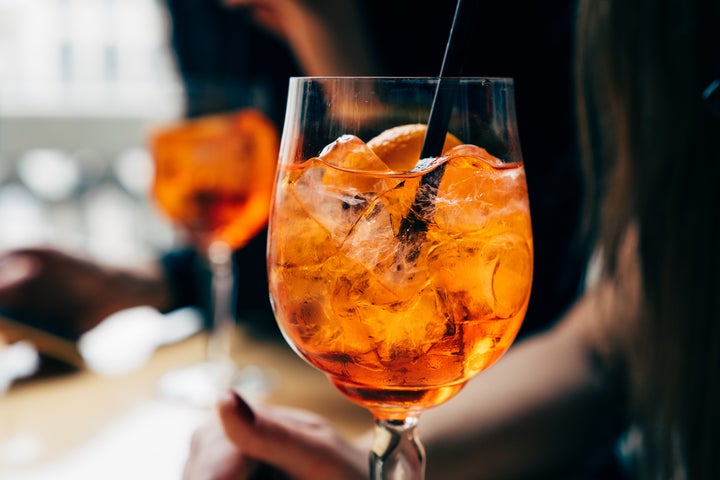
Just so you know, HuffPost UK may collect a share of sales or other compensation from the links on this page if you decide to shop from them.
It’s summer in half of the world, and that means one thing: half the world is asking for an Aperol Spritz. This orange-hued drink is simple – Aperol, prosecco, soda water, an orange slice and ice – and it’s been popular for the last few summers.
What’s its secret? We asked beverage industry folks to break it down: what we need to make the best drink, how we can avoid common spritz-making mistakes and their favourite tips and tricks.
The Aperol spritz is not a new trend
While it’s been back in the spotlight since 2016, the drink has been around much longer. “Spritz” comes from Spritzen, the name given to the result of Austro-Hungarian soldiers watering down Italian wine because they found it too strong. The nickname stuck. Anything can be a spritz! It basically means adding bubbles to a still drink, or a still drink to something bubbly.
Aperol was created by the Barbieri Brothers in 1919. It’s a bitter made primarily of gentian, rhubarb and cinchona with a bittersweet, citrusy flavour. In the 1950s, when Aperol was being marketed, all it took for the drink to take off was a TV commercial with the recipe:
The Aperol Spritz ingredients you need
The great thing about this cocktail is that the ingredients are available everywhere. You probably don’t need much advice about oranges or club soda, but here are some thoughts on the alcohol.
Aperol comes in 70cl bottles, enough for 12 spritzes and some tasting pours. If you have a curious friend who wants to know what it tastes like, it doesn’t take much – Aperol is intense and most people aren’t interested in more than a teeny sip. At £13-£16 per bottle, it’s not a bad investment and your at-home spritz will be just as good as one from a restaurant (and far less expensive).
If you can’t find Aperol, you can still make an Aperol-ish Spritz. While not exactly the same, Campari is a great option. Luxardo Bitter also works.

You’ll also need prosecco, Italy’s version of sparkling wine. It’s less expensive than Champagne, thanks to being made using a more efficient method and not needing to be aged as long.
If you’re making a smaller quantity, grab a pack of smaller bottles. These are a little 200ml, perfect for two spritzes and a little extra.
How to make an Aperol Spritz
According to Christina Demas, the beverage director of Maple & Ash + etta in Scottsdale, Arizona, the go-to classic recipe for an Aperol Spritz is:
Two half moon oranges
60ml Aperol
30ml soda water
90ml prosecco
crushed ice
fresh orange peel
The suggested glass is a white wine glass, but have fun with your glassware ― just make sure it’s clear so you can enjoy the gorgeous orange hue.
Fill 3/4 of the glass with ice. Then add the Aperol, soda water, prosecco and the orange garnish. That’s it!
Elliot Pascoe, the head bartender at Singapore’s 28 HongKong Street, shared a secret many don’t know: “The instructions are literally on the back of the bottle – follow them and add an olive.”
If the olive (make sure it’s green) stops you in your tracks, you didn’t read that wrong. “Olive and orange is the traditional garnish. The brine from the olive cuts the candy sweetness of the aperitif perfectly,” Pascoe says.
Common mistakes and how to avoid them
While it’s easy to master the ingredients and order, it’s still possible to make mistakes when mixing this drink. There are two mistakes the experts say are common.
The first mistake is adding the prosecco before the soda water. You should always add the soda water first. Because this drink isn’t mixed – mixing would flatten it – you’ll taste the fizz and flavour of prosecco, and then when the Aperol hits your palate, it’s through the soda water and prosecco, which lessens the Aperol’s bitterness.
The other mistake has to do with picking a prosecco. Make sure you use an extra dry or dry prosecco, not a brut (the driest option). You need a little sweetness to meet the bitter liqueur.